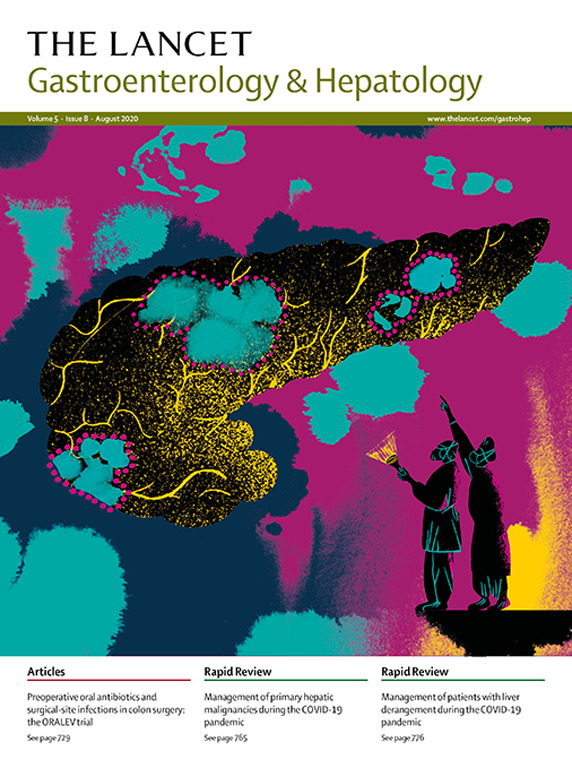Etrasimod as induction and maintenance treatment for patients with moderately to severely active ulcerative colitis in East Asia (ENLIGHT UC): a randomised, double-blind, placebo-controlled, multicentre, phase 3 study
IF 38.6
1区 医学
Q1 GASTROENTEROLOGY & HEPATOLOGY
引用次数: 0
Abstract
Background
Etrasimod is an oral, once-daily sphingosine 1-phosphate (S1P) receptor modulator for the treatment of active ulcerative colitis. In the randomised, placebo-controlled, double-blind phase 3 ENLIGHT UC study, also known as the ES101002 study, we aimed to evaluate the efficacy and safety of etrasimod in patients with moderately to severely active ulcerative colitis in East Asia.Methods
Using a central interactive web response system, in the 12-week induction period, adults (aged 18–75 years, inclusive) with moderately to severely active ulcerative colitis (modified Mayo score [MMS] 4–9 with an endoscopic subscore ≥2 and a rectal bleeding subscore ≥1) and an inadequate response, loss of response, or intolerance to at least one ulcerative colitis treatment were randomly assigned (2:1) to once-daily oral etrasimod 2 mg or placebo. Patients and study staff were masked to treatment assignment. Patients were enrolled from 52 hospitals across China, Taiwan, and Souh Korea. Randomisation was stratified by previous treatment status and baseline disease activity. Patients who had an MMS clinical response at induction period week 12 were re-randomly assigned (1:1) to once-daily oral etrasimod 2 mg or placebo for the 40-week maintenance period. Randomisation was stratified by induction period treatment, previous exposure to biologicals or JAK inhibitors, and concomitant use of oral corticosteroids at induction period baseline. The primary efficacy outcome was MMS clinical remission (stool frequency subscore=0 [or stool frequency subscore=1 with a ≥1 point decrease from induction period baseline], rectal bleeding subscore=0, and endoscopic subscore ≤1 [excluding friability]), assessed in the induction and maintenance periods separately (at induction period week 12 and maintenance period week 40). The primary efficacy analyses used the full analysis set (FAS), which included all patients who were randomly assigned and received at least one dose of study treatment for the induction period, and all re-randomly assigned patients who showed clinical response at induction period week 12 and received at least one dose of study treatment for the maintenance period. The safety analyses for each treatment period used the safety analysis set (SAF), which included all patients who received any amount of study drug in the corresponding treatment period. ENLIGHT UC is registered with ClinicalTrials.gov (NCT04176588) and the study is complete.Findings
606 patients were screened between Sept 25, 2019, and April 27, 2023, and 340 were randomly assigned for the induction period and treated (FAS: 228 patients [88 female and 140 male] assigned to etrasimod and 112 patients [44 female and 68 male] assigned to placebo). 157 patients who showed clinical response in the induction period were re-randomly assigned and treated in the maintenance period (FAS: 77 patients [35 female and 42 male] assigned to etrasimod and 80 patients [32 female and 48 male] assigned to placebo). A significantly greater proportion of patients treated with etrasimod than those treated with placebo, showed clinical remission at induction week 12 (57 [25·0%] of 228 patients vs six [5·4%] of 112 patients; adjusted difference 20·4%; 95% CI 13·4%–27·4%; p<0·0001) and maintenance period week 40 (37 [48·1%] of 77 patients vs 10 [12·5%] of 80 patients; adjusted difference 35·9%; 95% CI 22·5%–49·2%; p<0·0001). In the induction period, the most frequently reported treatment-emergent adverse event (TEAE) was increased ALT (22 [10%] in the etrasimod group vs one [1%] in the placebo group). In the maintenance period, the most frequently reported TEAE was upper respiratory tract infection (14 [18%] in the etrasimod group vs 14 [17%] in the placebo group). Across the induction and maintenance periods, most TEAEs were mild to moderate in severity. Five (2%) of 228 patients treated with etrasimod and four (4%) of 112 patients treated with placebo discontinued study treatment due to TEAEs during the induction period, and one (1%) of 77 patients treated with etrasimod and one (1%) of 81 patients treated with placebo discontinued study treatment due to TEAEs during the maintenance period. No grade 4 or higher TEAE, malignancies, or deaths were reported.Interpretation
Etrasimod was effective and well tolerated as an oral induction and maintenance treatment in patients with moderately to severely active ulcerative colitis in East Asia.Funding
Everest Medicines.Translation
For the Chinese translation of the abstract see Supplementary Materials section.Etrasimod作为东亚中度至重度活动性溃疡性结肠炎患者的诱导和维持治疗(ENLIGHT UC):一项随机、双盲、安慰剂对照、多中心、3期研究
detrasimod是一种口服,每日一次的鞘氨醇1-磷酸(S1P)受体调节剂,用于治疗活动性溃疡性结肠炎。在随机、安慰剂对照、双盲3期ENLIGHT UC研究(也称为ES101002研究)中,我们旨在评估etrasimod在东亚中度至重度活动性溃疡性结肠炎患者中的疗效和安全性。方法采用中心互动网络反应系统,在12周的诱导期内,中度至重度活动性溃疡性结肠炎(改良梅奥评分[MMS] 4-9,内镜亚评分≥2,直肠出血亚评分≥1)和对至少一种溃疡性结肠炎治疗反应不足、反应消失或不耐受的成年人(年龄18-75岁,含)随机(2:1)分配到每日一次口服伊特西莫德2mg或安慰剂组。患者和研究人员被蒙面接受治疗分配。患者来自中国大陆、台湾和韩国的52家医院。随机化按既往治疗状态和基线疾病活动度分层。在诱导期第12周有MMS临床反应的患者被重新随机分配(1:1),在40周的维持期每天一次口服2mg etrasimod或安慰剂。随机分组根据诱导期治疗、既往暴露于生物制剂或JAK抑制剂以及在诱导期基线时同时使用口服皮质类固醇进行分层。主要疗效指标为MMS临床缓解(大便频率评分=0[或大便频率评分=1,较诱导期基线降低≥1分],直肠出血评分=0,内镜下评分≤1[不包括易损性]),分别在诱导期和维持期(诱导期第12周和维持期第40周)评估。主要疗效分析使用完整分析集(FAS),其中包括所有随机分配并在诱导期接受至少一剂研究治疗的患者,以及所有重新随机分配的在诱导期第12周显示临床反应并在维持期接受至少一剂研究治疗的患者。每个治疗期的安全性分析使用安全分析集(SAF),其中包括在相应治疗期接受任意剂量研究药物的所有患者。ENLIGHT UC已在ClinicalTrials.gov注册(NCT04176588),研究已经完成。在2019年9月25日至2023年4月27日期间,对606名患者进行了筛查,其中340名患者随机分配到诱导期并接受治疗(FAS: 228名患者(88名女性和140名男性)分配到etrasimod组,112名患者(44名女性和68名男性)分配到安慰剂组)。157例在诱导期表现出临床反应的患者被重新随机分配,并在维持期接受治疗(FAS: 77例患者(35名女性,42名男性)被分配给etrasimod, 80例患者(32名女性,48名男性)被分配给安慰剂)。在诱导期第12周(228例患者中有57例[25.0%]对112例患者中有6例[5.4%])和维持期第40周(77例患者中有37例[48.1%]对80例患者中有10例[12.5%])出现临床缓解(etrasimod组患者比例显著高于安慰剂组患者)。在诱导期,最常见的治疗不良事件(TEAE)是ALT升高(etrasimod组为22例[10%],安慰剂组为1例[1%])。在维持期,最常见的TEAE报告是上呼吸道感染(伊特拉西莫组14例[18%]vs安慰剂组14例[17%])。在诱导和维持期间,大多数teae的严重程度为轻度至中度。228名接受etrasimod治疗的患者中有5名(2%)和112名接受安慰剂治疗的患者中有4名(4%)在诱导期因teae而停止研究治疗,77名接受etrasimod治疗的患者中有1名(1%)和81名接受安慰剂治疗的患者中有1名(1%)在维持期因teae而停止研究治疗。没有4级或以上TEAE、恶性肿瘤或死亡的报道。在东亚地区,etrasimod作为一种口服诱导和维持治疗中至重度活动性溃疡性结肠炎患者是有效且耐受性良好的。FundingEverest药物。摘要的中文译文见补充资料部分。
本文章由计算机程序翻译,如有差异,请以英文原文为准。
求助全文
约1分钟内获得全文
求助全文
来源期刊

Lancet Gastroenterology & Hepatology
Medicine-Hepatology
CiteScore
50.30
自引率
1.10%
发文量
0
期刊介绍:
The Lancet Gastroenterology & Hepatology is an authoritative forum for key opinion leaders across medicine, government, and health systems to influence clinical practice, explore global policy, and inform constructive, positive change worldwide.
The Lancet Gastroenterology & Hepatology publishes papers that reflect the rich variety of ongoing clinical research in these fields, especially in the areas of inflammatory bowel diseases, NAFLD and NASH, functional gastrointestinal disorders, digestive cancers, and viral hepatitis.
 求助内容:
求助内容: 应助结果提醒方式:
应助结果提醒方式:


